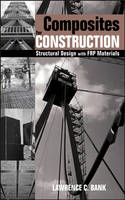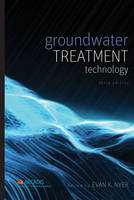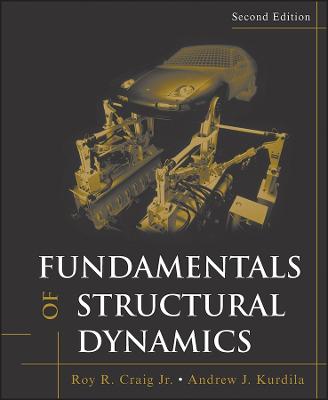Composites for Construction
 -15%
portes grátis
-15%
portes grátis
Composites for Construction
Structural Design with FRP Materials
Bank, Lawrence C.
John Wiley & Sons Inc
08/2006
576
Dura
Inglês
9780471681267
15 a 20 dias
1068
Descrição não disponível.
Chapter 1. Introduction. 1.1. Overview.
1.2. Historical Background.
1.3. FRP Reinforcements for New Concrete Structural Members.
1.3.1. FRP bars or grids for reinforced concrete (RC) members.
1.3.2. FRP tendons for prestressed concrete (PC) members.
1.3.3. Stay-in-Place FRP formwork for reinforced concrete (RC) members.
1.4. FRP Strengthening of Existing Structural Members .
1.5. FRP Profiles for New Structures.
1.6. Other Emerging Applications of Interest to Structural Engineers.
1.7. Properties of FRP products for Structural Engineering Design.
1.8. Published Design Guides, Codes and Specifications for FRP Composites in Structural Engineering..
1.8.1. FRP Reinforcing Bars and Tendons.
1.8.2. FRP Strengthening Systems.
1.8.3. FRP Pultruded Profiles.
1.8.4. Manufacturer Design Manuals.
1.8.5. Key Conferences Series.
1.8.6. Archival Journals.
Chapter 2. Materials and Manufacturing.
2.1. Overview.
2.2. Raw Materials.
2.2.1. Reinforcing Fibers.
2.2.2. Polymer Resins.
2.3. Manufacturing Methods.
2.3.1. Pultrusion.
2.3.2. Hand-layup.
2.3.3. Other Manufacturing Processes.
Chapter 3. Properties of FRP Composites .
3.1. Overview .
3.2. Theoretical determination of properties.
3.2.1. The fiber level .
3.2.2. The lamina level .
3.2.3. The laminate level.
3.2.4. The full-section level .
3.3. Experimental determination of properties .
3.3.1. The fiber level .
3.3.2. The lamina level.
3.3.3. The laminate level.
3.3.4. The full-section level .
3.4. Relevant Standard Test Methods for FRP Composites for Structural Engineers.
3.4.1. American Society of Testing and Materials (ASTM).
Chapter 4. Design Basis for FRP Reinforcements.
4.1. Overview.
4.2. Introduction.
4.3. Properties of FRP Reinforcing Bars.
4.4. Design Basis for FRP Reinforced Concrete .
4.4.1. Resistance factors.
4.4.2. Minimum reinforcement requirements.
4.4.3. Determination of guaranteed properties of FRP rebars.
4.4.4. Design for environmental effects on FRP rebars.
4.4.5. Special considerations FRP rebars.
4.4.6. Design for serviceability.
4.4.7. Temperature and shrinkage reinforcement in slabs.
Chapter 5. FRP Flexural Reinforcement.
5.1. Overview.
5.2. Introduction.
5.3. Flexural Strength of an FRP Reinforced Section.
5.3.1. The over-reinforced section.
5.3.2. The under-reinforced section.
5.3.3. Minimum flexural reinforcement.
5.4. Design procedure for an FRP reinforced flexural member.
5.4.1. Design of FRP reinforced bridge deck slabs.
5.5. Serviceability design of FRP reinforced beams.
5.5.1. Deflections under service loads.
5.5.2. Flexural Cracking.
5.5.3. Creep and Fatigue at Service Loads.
5.6. Design procedure for serviceability.
Chapter 6. FRP Shear Reinforcement .
6.1. Overview.
6.2. Introduction.
6.3. Shear design of an FRP reinforced concrete section.
6.3.1. The concrete contribution to shear capacity.
6.3.2. Shear capacity of FRP stirrups.
6.3.3. Punching shear capacity in slabs.
6.4. Limits on shear reinforcement and shear strengths for shear design.
6.5. Design procedure for FRP shear reinforcement.
Chapter 7. FRP Reinforcement Detailing.
7.1. Overview.
7.2. Introduction.
7.3. Geometric details.
7.3.1. Calculation of bar spacing.
7.4. Bond strength of FRP bars.
7.5. Development of straight FRP bars.
7.6. Development of hooked FRP bars.
7.7. Lap splices for FRP bars.
7.8. Design procedure to detail FRP bars in a beam.
Chapter 8. Design Basis for FRP Strengthening.
8.1. Overview.
8.2. Introduction.
8.3. Properties of FRP Strengthening Systems.
8.4. Design Basis for FRP Strengthening Systems .
8.4.1. Resistance Factors.
8.4.2. Guaranteed properties.
8.4.3. Environmental effects.
8.4.4. Limits of strengthening.
8.4.5. Limits on stresses in FRP strengthening systems at service loads.
8.4.6. Compression strengthening in flexural members.
8.5. Deflections in FRP strengthened structures.
8.6. FRP strengthening system area calculations.
Chapter 9. FRP Flexural Strengthening.
9.1. Overview.
9.2. Introduction to FRP flexural strengthening .
9.3. Flexural capacity of an FRP strengthened member.
9.3.1. Stress in the FRP strengthening system.
9.3.2. Strain in the internal reinforcing steel .
9.3.3. Neutral axis depth.
9.3.4. The existing substrate strain.
9.4. Determination of failure modes and flexural capacity.
9.4.1. Mode 1a - Concrete crushing after steel yields.
9.4.2. Mode 1b - Concrete crushing before steel yields.
9.4.3. Mode 2a - FRP failure after steel yields .
9.4.4. Mode 2b - FRP failure before steel yields.
9.5. The Balanced Condition.
9.6. Detailing for flexural strengthening.
9.7. Design Procedure for a flexurally strengthened concrete member.
9.8. Serviceability of FRP strengthened flexural members.
9.8.1. The cracked FRP strengthened section.
9.8.2. Service level stress in the internal steel reinforcing bars.
9.8.3. Service level stresses in the FRP strengthening system.
9.9. Load-deflection response of FRP strengthened flexural members.
Chapter 10. FRP Shear Strengthening.
10.1. Overview.
10.2. Introduction to FRP shear strengthening.
10.3. Shear capacity of an FRP strengthened member.
10.4. Effective strain in the FRP for shear strengthening .
10.5. Design Procedure for shear strengthening.
10.6. Shear strengthening of fully-wrapped axially loaded columns .
Chapter 11. FRP Confining.
11.1. Overview.
11.2. Introduction to FRP confining.
11.3. FRP confining for axial strengthening.
11.3.1. Serviceability for FRP strengthened axial members.
11.4. Design procedure for FRP axial strengthening of RC circular columns.
11.5. FRP strengthened eccentrically-loaded columns .
11.6. FRP confining for increased ductility.
11.6.1. Lateral Displacement Ductility.
11.6.2. Flexural Hinge Confinement.
11.7. Design Procedure for Flexural Hinge Confinement.
11.8. Lap Splice Region Confinement.
11.9. Plastic Shear Overstrength Demand.
Chapter 12. Design Basis for FRP Profiles.
12.1. Overview.
12.2 Introduction.
12.3. Properties of Pultruded Profiles.
12.4. Design Basis for FRP Pultruded Structures.
12.4.1. Allowable Stress Design (ASD).
12.4.2. Load and Resistance Factor Design (LRFD).
12.5. Performance Based Design (PBD).
Chapter 13. Pultruded Flexural Members.
13.1. Overview.
13.2. Introduction to pultruded flexural members.
13.3. Stresses in flexural members.
13.4. Deformations in flexural members.
13.5. Determination of deflections and stresses for serviceability and ultimate limit states.
13.6. Serviceability limits states.
13.6.1. Deformation limit state ? transverse deflection.
13.6.2. Long-term deflection in pultruded beams.
13.7. Ultimate limit states.
13.7.1. Lateral-torsional buckling.
13.7.2. Local buckling of walls due to in-plane compression.
13.7.3. Local buckling of walls due to in-plane shear .
13.7.4. Web crushing and web buckling in the transverse direction.
13.7.5. Additional factors affecting local buckling in pultruded profiles.
13.7.6. Flange and web longitudinal material failure .
13.7.7. Flange and web material shear failure .
13.8. Design procedure for flexural members.
Chapter 14. Pultruded Axial Members.
14.1. Overview.
14.2. Introduction to pultruded axial members.
14.3. Concentrically loaded compression members.
14.4. Deformations in concentrically loaded compression members.
14.5. Determination of deflections and stresses for serviceability and ultimate limit states.
14.6. Serviceability limits states.
14.6.1. Deformation limit state ? axial shortening.
14.7. Ultimate limit states.
14.7.1. Global flexural buckling.
14.7.2. Global torsional buckling.
14.7.3. Local buckling due to axial loads.
14.7.4. Interaction between local and global buckling modes in intermediate length compression members.
14.7.5. Flange and web longitudinal material failure .
14.8. Design procedure for concentrically loaded compression members.
14.9. Concentrically loaded tension members.
14.9.1 Deformations in concentrically loaded tension members.
14.10. Determination of deflections and stresses for serviceability and ultimate limit states.
14.10.1. Deformation limit state ? axial elongation .
14.11. Ultimate limit states.
14.11.1. Longitudinal material failure on the gross area .
14.11.2. Longitudinal material failure on the net area .
14.12. Design procedure for concentrically loaded tension members.
14.13. Combined load members.
14.13.1. Members subjected to combined flexure and compression (beam-columns).
14.13.2. Members subjected to combined flexure and tension .
Chapter 15. Pultruded Connections.
15.1. Overview.
15.2. Introduction to pultruded connections.
15.2.1. Conventional Pultruded Connections.
15.2.2 Custom Pultruded Connections.
15.3. Mechanical Fasteners and Connection Parts.
15.3.1. FRP nuts and bolts.
15.4. Research on Heavy Beam-to-column Pultruded Connections .
15.5. Bolted Pultruded Connections.
15.6. Light-truss pultruded connections.
15.6.1. Lap-joint connections.
15.7. Heavy frame pultruded connections.
15.8. Design of bolted pultruded connections.
15.9. Determination of stresses in in-plane lap-joints.
15.9.1 Bearing stress in the base pultruded material.
15.9.2. Net-tension stress in the base pultruded material.
15.9.3. Shear-out stress in the base pultruded material.
15.9.4. Shear stress on the bolt.
15.10. Stresses in out-of-plane shear connections.
15.10.1. Longitudinal shear stress at the heel of the angle.
15.10.2. Flexural stress in the leg of the angle bolted to the column member.
15.10.3. Transverse tensile stress in the web-flange junction of the column.
15.10.4. Block shear in the beam web.
15.10.5. Flexural and shear stresses in flexible seated connections.
15.11. Critical Connection Limit States.
15.12. Design Procedure for a pultruded connection.
1.2. Historical Background.
1.3. FRP Reinforcements for New Concrete Structural Members.
1.3.1. FRP bars or grids for reinforced concrete (RC) members.
1.3.2. FRP tendons for prestressed concrete (PC) members.
1.3.3. Stay-in-Place FRP formwork for reinforced concrete (RC) members.
1.4. FRP Strengthening of Existing Structural Members .
1.5. FRP Profiles for New Structures.
1.6. Other Emerging Applications of Interest to Structural Engineers.
1.7. Properties of FRP products for Structural Engineering Design.
1.8. Published Design Guides, Codes and Specifications for FRP Composites in Structural Engineering..
1.8.1. FRP Reinforcing Bars and Tendons.
1.8.2. FRP Strengthening Systems.
1.8.3. FRP Pultruded Profiles.
1.8.4. Manufacturer Design Manuals.
1.8.5. Key Conferences Series.
1.8.6. Archival Journals.
Chapter 2. Materials and Manufacturing.
2.1. Overview.
2.2. Raw Materials.
2.2.1. Reinforcing Fibers.
2.2.2. Polymer Resins.
2.3. Manufacturing Methods.
2.3.1. Pultrusion.
2.3.2. Hand-layup.
2.3.3. Other Manufacturing Processes.
Chapter 3. Properties of FRP Composites .
3.1. Overview .
3.2. Theoretical determination of properties.
3.2.1. The fiber level .
3.2.2. The lamina level .
3.2.3. The laminate level.
3.2.4. The full-section level .
3.3. Experimental determination of properties .
3.3.1. The fiber level .
3.3.2. The lamina level.
3.3.3. The laminate level.
3.3.4. The full-section level .
3.4. Relevant Standard Test Methods for FRP Composites for Structural Engineers.
3.4.1. American Society of Testing and Materials (ASTM).
Chapter 4. Design Basis for FRP Reinforcements.
4.1. Overview.
4.2. Introduction.
4.3. Properties of FRP Reinforcing Bars.
4.4. Design Basis for FRP Reinforced Concrete .
4.4.1. Resistance factors.
4.4.2. Minimum reinforcement requirements.
4.4.3. Determination of guaranteed properties of FRP rebars.
4.4.4. Design for environmental effects on FRP rebars.
4.4.5. Special considerations FRP rebars.
4.4.6. Design for serviceability.
4.4.7. Temperature and shrinkage reinforcement in slabs.
Chapter 5. FRP Flexural Reinforcement.
5.1. Overview.
5.2. Introduction.
5.3. Flexural Strength of an FRP Reinforced Section.
5.3.1. The over-reinforced section.
5.3.2. The under-reinforced section.
5.3.3. Minimum flexural reinforcement.
5.4. Design procedure for an FRP reinforced flexural member.
5.4.1. Design of FRP reinforced bridge deck slabs.
5.5. Serviceability design of FRP reinforced beams.
5.5.1. Deflections under service loads.
5.5.2. Flexural Cracking.
5.5.3. Creep and Fatigue at Service Loads.
5.6. Design procedure for serviceability.
Chapter 6. FRP Shear Reinforcement .
6.1. Overview.
6.2. Introduction.
6.3. Shear design of an FRP reinforced concrete section.
6.3.1. The concrete contribution to shear capacity.
6.3.2. Shear capacity of FRP stirrups.
6.3.3. Punching shear capacity in slabs.
6.4. Limits on shear reinforcement and shear strengths for shear design.
6.5. Design procedure for FRP shear reinforcement.
Chapter 7. FRP Reinforcement Detailing.
7.1. Overview.
7.2. Introduction.
7.3. Geometric details.
7.3.1. Calculation of bar spacing.
7.4. Bond strength of FRP bars.
7.5. Development of straight FRP bars.
7.6. Development of hooked FRP bars.
7.7. Lap splices for FRP bars.
7.8. Design procedure to detail FRP bars in a beam.
Chapter 8. Design Basis for FRP Strengthening.
8.1. Overview.
8.2. Introduction.
8.3. Properties of FRP Strengthening Systems.
8.4. Design Basis for FRP Strengthening Systems .
8.4.1. Resistance Factors.
8.4.2. Guaranteed properties.
8.4.3. Environmental effects.
8.4.4. Limits of strengthening.
8.4.5. Limits on stresses in FRP strengthening systems at service loads.
8.4.6. Compression strengthening in flexural members.
8.5. Deflections in FRP strengthened structures.
8.6. FRP strengthening system area calculations.
Chapter 9. FRP Flexural Strengthening.
9.1. Overview.
9.2. Introduction to FRP flexural strengthening .
9.3. Flexural capacity of an FRP strengthened member.
9.3.1. Stress in the FRP strengthening system.
9.3.2. Strain in the internal reinforcing steel .
9.3.3. Neutral axis depth.
9.3.4. The existing substrate strain.
9.4. Determination of failure modes and flexural capacity.
9.4.1. Mode 1a - Concrete crushing after steel yields.
9.4.2. Mode 1b - Concrete crushing before steel yields.
9.4.3. Mode 2a - FRP failure after steel yields .
9.4.4. Mode 2b - FRP failure before steel yields.
9.5. The Balanced Condition.
9.6. Detailing for flexural strengthening.
9.7. Design Procedure for a flexurally strengthened concrete member.
9.8. Serviceability of FRP strengthened flexural members.
9.8.1. The cracked FRP strengthened section.
9.8.2. Service level stress in the internal steel reinforcing bars.
9.8.3. Service level stresses in the FRP strengthening system.
9.9. Load-deflection response of FRP strengthened flexural members.
Chapter 10. FRP Shear Strengthening.
10.1. Overview.
10.2. Introduction to FRP shear strengthening.
10.3. Shear capacity of an FRP strengthened member.
10.4. Effective strain in the FRP for shear strengthening .
10.5. Design Procedure for shear strengthening.
10.6. Shear strengthening of fully-wrapped axially loaded columns .
Chapter 11. FRP Confining.
11.1. Overview.
11.2. Introduction to FRP confining.
11.3. FRP confining for axial strengthening.
11.3.1. Serviceability for FRP strengthened axial members.
11.4. Design procedure for FRP axial strengthening of RC circular columns.
11.5. FRP strengthened eccentrically-loaded columns .
11.6. FRP confining for increased ductility.
11.6.1. Lateral Displacement Ductility.
11.6.2. Flexural Hinge Confinement.
11.7. Design Procedure for Flexural Hinge Confinement.
11.8. Lap Splice Region Confinement.
11.9. Plastic Shear Overstrength Demand.
Chapter 12. Design Basis for FRP Profiles.
12.1. Overview.
12.2 Introduction.
12.3. Properties of Pultruded Profiles.
12.4. Design Basis for FRP Pultruded Structures.
12.4.1. Allowable Stress Design (ASD).
12.4.2. Load and Resistance Factor Design (LRFD).
12.5. Performance Based Design (PBD).
Chapter 13. Pultruded Flexural Members.
13.1. Overview.
13.2. Introduction to pultruded flexural members.
13.3. Stresses in flexural members.
13.4. Deformations in flexural members.
13.5. Determination of deflections and stresses for serviceability and ultimate limit states.
13.6. Serviceability limits states.
13.6.1. Deformation limit state ? transverse deflection.
13.6.2. Long-term deflection in pultruded beams.
13.7. Ultimate limit states.
13.7.1. Lateral-torsional buckling.
13.7.2. Local buckling of walls due to in-plane compression.
13.7.3. Local buckling of walls due to in-plane shear .
13.7.4. Web crushing and web buckling in the transverse direction.
13.7.5. Additional factors affecting local buckling in pultruded profiles.
13.7.6. Flange and web longitudinal material failure .
13.7.7. Flange and web material shear failure .
13.8. Design procedure for flexural members.
Chapter 14. Pultruded Axial Members.
14.1. Overview.
14.2. Introduction to pultruded axial members.
14.3. Concentrically loaded compression members.
14.4. Deformations in concentrically loaded compression members.
14.5. Determination of deflections and stresses for serviceability and ultimate limit states.
14.6. Serviceability limits states.
14.6.1. Deformation limit state ? axial shortening.
14.7. Ultimate limit states.
14.7.1. Global flexural buckling.
14.7.2. Global torsional buckling.
14.7.3. Local buckling due to axial loads.
14.7.4. Interaction between local and global buckling modes in intermediate length compression members.
14.7.5. Flange and web longitudinal material failure .
14.8. Design procedure for concentrically loaded compression members.
14.9. Concentrically loaded tension members.
14.9.1 Deformations in concentrically loaded tension members.
14.10. Determination of deflections and stresses for serviceability and ultimate limit states.
14.10.1. Deformation limit state ? axial elongation .
14.11. Ultimate limit states.
14.11.1. Longitudinal material failure on the gross area .
14.11.2. Longitudinal material failure on the net area .
14.12. Design procedure for concentrically loaded tension members.
14.13. Combined load members.
14.13.1. Members subjected to combined flexure and compression (beam-columns).
14.13.2. Members subjected to combined flexure and tension .
Chapter 15. Pultruded Connections.
15.1. Overview.
15.2. Introduction to pultruded connections.
15.2.1. Conventional Pultruded Connections.
15.2.2 Custom Pultruded Connections.
15.3. Mechanical Fasteners and Connection Parts.
15.3.1. FRP nuts and bolts.
15.4. Research on Heavy Beam-to-column Pultruded Connections .
15.5. Bolted Pultruded Connections.
15.6. Light-truss pultruded connections.
15.6.1. Lap-joint connections.
15.7. Heavy frame pultruded connections.
15.8. Design of bolted pultruded connections.
15.9. Determination of stresses in in-plane lap-joints.
15.9.1 Bearing stress in the base pultruded material.
15.9.2. Net-tension stress in the base pultruded material.
15.9.3. Shear-out stress in the base pultruded material.
15.9.4. Shear stress on the bolt.
15.10. Stresses in out-of-plane shear connections.
15.10.1. Longitudinal shear stress at the heel of the angle.
15.10.2. Flexural stress in the leg of the angle bolted to the column member.
15.10.3. Transverse tensile stress in the web-flange junction of the column.
15.10.4. Block shear in the beam web.
15.10.5. Flexural and shear stresses in flexible seated connections.
15.11. Critical Connection Limit States.
15.12. Design Procedure for a pultruded connection.
Este título pertence ao(s) assunto(s) indicados(s). Para ver outros títulos clique no assunto desejado.
structural engineering, ACI 440, ASCE Structural Plastics Design Manual, EUROCOMP Design Code, AASHTO, pultrusion process
Chapter 1. Introduction. 1.1. Overview.
1.2. Historical Background.
1.3. FRP Reinforcements for New Concrete Structural Members.
1.3.1. FRP bars or grids for reinforced concrete (RC) members.
1.3.2. FRP tendons for prestressed concrete (PC) members.
1.3.3. Stay-in-Place FRP formwork for reinforced concrete (RC) members.
1.4. FRP Strengthening of Existing Structural Members .
1.5. FRP Profiles for New Structures.
1.6. Other Emerging Applications of Interest to Structural Engineers.
1.7. Properties of FRP products for Structural Engineering Design.
1.8. Published Design Guides, Codes and Specifications for FRP Composites in Structural Engineering..
1.8.1. FRP Reinforcing Bars and Tendons.
1.8.2. FRP Strengthening Systems.
1.8.3. FRP Pultruded Profiles.
1.8.4. Manufacturer Design Manuals.
1.8.5. Key Conferences Series.
1.8.6. Archival Journals.
Chapter 2. Materials and Manufacturing.
2.1. Overview.
2.2. Raw Materials.
2.2.1. Reinforcing Fibers.
2.2.2. Polymer Resins.
2.3. Manufacturing Methods.
2.3.1. Pultrusion.
2.3.2. Hand-layup.
2.3.3. Other Manufacturing Processes.
Chapter 3. Properties of FRP Composites .
3.1. Overview .
3.2. Theoretical determination of properties.
3.2.1. The fiber level .
3.2.2. The lamina level .
3.2.3. The laminate level.
3.2.4. The full-section level .
3.3. Experimental determination of properties .
3.3.1. The fiber level .
3.3.2. The lamina level.
3.3.3. The laminate level.
3.3.4. The full-section level .
3.4. Relevant Standard Test Methods for FRP Composites for Structural Engineers.
3.4.1. American Society of Testing and Materials (ASTM).
Chapter 4. Design Basis for FRP Reinforcements.
4.1. Overview.
4.2. Introduction.
4.3. Properties of FRP Reinforcing Bars.
4.4. Design Basis for FRP Reinforced Concrete .
4.4.1. Resistance factors.
4.4.2. Minimum reinforcement requirements.
4.4.3. Determination of guaranteed properties of FRP rebars.
4.4.4. Design for environmental effects on FRP rebars.
4.4.5. Special considerations FRP rebars.
4.4.6. Design for serviceability.
4.4.7. Temperature and shrinkage reinforcement in slabs.
Chapter 5. FRP Flexural Reinforcement.
5.1. Overview.
5.2. Introduction.
5.3. Flexural Strength of an FRP Reinforced Section.
5.3.1. The over-reinforced section.
5.3.2. The under-reinforced section.
5.3.3. Minimum flexural reinforcement.
5.4. Design procedure for an FRP reinforced flexural member.
5.4.1. Design of FRP reinforced bridge deck slabs.
5.5. Serviceability design of FRP reinforced beams.
5.5.1. Deflections under service loads.
5.5.2. Flexural Cracking.
5.5.3. Creep and Fatigue at Service Loads.
5.6. Design procedure for serviceability.
Chapter 6. FRP Shear Reinforcement .
6.1. Overview.
6.2. Introduction.
6.3. Shear design of an FRP reinforced concrete section.
6.3.1. The concrete contribution to shear capacity.
6.3.2. Shear capacity of FRP stirrups.
6.3.3. Punching shear capacity in slabs.
6.4. Limits on shear reinforcement and shear strengths for shear design.
6.5. Design procedure for FRP shear reinforcement.
Chapter 7. FRP Reinforcement Detailing.
7.1. Overview.
7.2. Introduction.
7.3. Geometric details.
7.3.1. Calculation of bar spacing.
7.4. Bond strength of FRP bars.
7.5. Development of straight FRP bars.
7.6. Development of hooked FRP bars.
7.7. Lap splices for FRP bars.
7.8. Design procedure to detail FRP bars in a beam.
Chapter 8. Design Basis for FRP Strengthening.
8.1. Overview.
8.2. Introduction.
8.3. Properties of FRP Strengthening Systems.
8.4. Design Basis for FRP Strengthening Systems .
8.4.1. Resistance Factors.
8.4.2. Guaranteed properties.
8.4.3. Environmental effects.
8.4.4. Limits of strengthening.
8.4.5. Limits on stresses in FRP strengthening systems at service loads.
8.4.6. Compression strengthening in flexural members.
8.5. Deflections in FRP strengthened structures.
8.6. FRP strengthening system area calculations.
Chapter 9. FRP Flexural Strengthening.
9.1. Overview.
9.2. Introduction to FRP flexural strengthening .
9.3. Flexural capacity of an FRP strengthened member.
9.3.1. Stress in the FRP strengthening system.
9.3.2. Strain in the internal reinforcing steel .
9.3.3. Neutral axis depth.
9.3.4. The existing substrate strain.
9.4. Determination of failure modes and flexural capacity.
9.4.1. Mode 1a - Concrete crushing after steel yields.
9.4.2. Mode 1b - Concrete crushing before steel yields.
9.4.3. Mode 2a - FRP failure after steel yields .
9.4.4. Mode 2b - FRP failure before steel yields.
9.5. The Balanced Condition.
9.6. Detailing for flexural strengthening.
9.7. Design Procedure for a flexurally strengthened concrete member.
9.8. Serviceability of FRP strengthened flexural members.
9.8.1. The cracked FRP strengthened section.
9.8.2. Service level stress in the internal steel reinforcing bars.
9.8.3. Service level stresses in the FRP strengthening system.
9.9. Load-deflection response of FRP strengthened flexural members.
Chapter 10. FRP Shear Strengthening.
10.1. Overview.
10.2. Introduction to FRP shear strengthening.
10.3. Shear capacity of an FRP strengthened member.
10.4. Effective strain in the FRP for shear strengthening .
10.5. Design Procedure for shear strengthening.
10.6. Shear strengthening of fully-wrapped axially loaded columns .
Chapter 11. FRP Confining.
11.1. Overview.
11.2. Introduction to FRP confining.
11.3. FRP confining for axial strengthening.
11.3.1. Serviceability for FRP strengthened axial members.
11.4. Design procedure for FRP axial strengthening of RC circular columns.
11.5. FRP strengthened eccentrically-loaded columns .
11.6. FRP confining for increased ductility.
11.6.1. Lateral Displacement Ductility.
11.6.2. Flexural Hinge Confinement.
11.7. Design Procedure for Flexural Hinge Confinement.
11.8. Lap Splice Region Confinement.
11.9. Plastic Shear Overstrength Demand.
Chapter 12. Design Basis for FRP Profiles.
12.1. Overview.
12.2 Introduction.
12.3. Properties of Pultruded Profiles.
12.4. Design Basis for FRP Pultruded Structures.
12.4.1. Allowable Stress Design (ASD).
12.4.2. Load and Resistance Factor Design (LRFD).
12.5. Performance Based Design (PBD).
Chapter 13. Pultruded Flexural Members.
13.1. Overview.
13.2. Introduction to pultruded flexural members.
13.3. Stresses in flexural members.
13.4. Deformations in flexural members.
13.5. Determination of deflections and stresses for serviceability and ultimate limit states.
13.6. Serviceability limits states.
13.6.1. Deformation limit state ? transverse deflection.
13.6.2. Long-term deflection in pultruded beams.
13.7. Ultimate limit states.
13.7.1. Lateral-torsional buckling.
13.7.2. Local buckling of walls due to in-plane compression.
13.7.3. Local buckling of walls due to in-plane shear .
13.7.4. Web crushing and web buckling in the transverse direction.
13.7.5. Additional factors affecting local buckling in pultruded profiles.
13.7.6. Flange and web longitudinal material failure .
13.7.7. Flange and web material shear failure .
13.8. Design procedure for flexural members.
Chapter 14. Pultruded Axial Members.
14.1. Overview.
14.2. Introduction to pultruded axial members.
14.3. Concentrically loaded compression members.
14.4. Deformations in concentrically loaded compression members.
14.5. Determination of deflections and stresses for serviceability and ultimate limit states.
14.6. Serviceability limits states.
14.6.1. Deformation limit state ? axial shortening.
14.7. Ultimate limit states.
14.7.1. Global flexural buckling.
14.7.2. Global torsional buckling.
14.7.3. Local buckling due to axial loads.
14.7.4. Interaction between local and global buckling modes in intermediate length compression members.
14.7.5. Flange and web longitudinal material failure .
14.8. Design procedure for concentrically loaded compression members.
14.9. Concentrically loaded tension members.
14.9.1 Deformations in concentrically loaded tension members.
14.10. Determination of deflections and stresses for serviceability and ultimate limit states.
14.10.1. Deformation limit state ? axial elongation .
14.11. Ultimate limit states.
14.11.1. Longitudinal material failure on the gross area .
14.11.2. Longitudinal material failure on the net area .
14.12. Design procedure for concentrically loaded tension members.
14.13. Combined load members.
14.13.1. Members subjected to combined flexure and compression (beam-columns).
14.13.2. Members subjected to combined flexure and tension .
Chapter 15. Pultruded Connections.
15.1. Overview.
15.2. Introduction to pultruded connections.
15.2.1. Conventional Pultruded Connections.
15.2.2 Custom Pultruded Connections.
15.3. Mechanical Fasteners and Connection Parts.
15.3.1. FRP nuts and bolts.
15.4. Research on Heavy Beam-to-column Pultruded Connections .
15.5. Bolted Pultruded Connections.
15.6. Light-truss pultruded connections.
15.6.1. Lap-joint connections.
15.7. Heavy frame pultruded connections.
15.8. Design of bolted pultruded connections.
15.9. Determination of stresses in in-plane lap-joints.
15.9.1 Bearing stress in the base pultruded material.
15.9.2. Net-tension stress in the base pultruded material.
15.9.3. Shear-out stress in the base pultruded material.
15.9.4. Shear stress on the bolt.
15.10. Stresses in out-of-plane shear connections.
15.10.1. Longitudinal shear stress at the heel of the angle.
15.10.2. Flexural stress in the leg of the angle bolted to the column member.
15.10.3. Transverse tensile stress in the web-flange junction of the column.
15.10.4. Block shear in the beam web.
15.10.5. Flexural and shear stresses in flexible seated connections.
15.11. Critical Connection Limit States.
15.12. Design Procedure for a pultruded connection.
1.2. Historical Background.
1.3. FRP Reinforcements for New Concrete Structural Members.
1.3.1. FRP bars or grids for reinforced concrete (RC) members.
1.3.2. FRP tendons for prestressed concrete (PC) members.
1.3.3. Stay-in-Place FRP formwork for reinforced concrete (RC) members.
1.4. FRP Strengthening of Existing Structural Members .
1.5. FRP Profiles for New Structures.
1.6. Other Emerging Applications of Interest to Structural Engineers.
1.7. Properties of FRP products for Structural Engineering Design.
1.8. Published Design Guides, Codes and Specifications for FRP Composites in Structural Engineering..
1.8.1. FRP Reinforcing Bars and Tendons.
1.8.2. FRP Strengthening Systems.
1.8.3. FRP Pultruded Profiles.
1.8.4. Manufacturer Design Manuals.
1.8.5. Key Conferences Series.
1.8.6. Archival Journals.
Chapter 2. Materials and Manufacturing.
2.1. Overview.
2.2. Raw Materials.
2.2.1. Reinforcing Fibers.
2.2.2. Polymer Resins.
2.3. Manufacturing Methods.
2.3.1. Pultrusion.
2.3.2. Hand-layup.
2.3.3. Other Manufacturing Processes.
Chapter 3. Properties of FRP Composites .
3.1. Overview .
3.2. Theoretical determination of properties.
3.2.1. The fiber level .
3.2.2. The lamina level .
3.2.3. The laminate level.
3.2.4. The full-section level .
3.3. Experimental determination of properties .
3.3.1. The fiber level .
3.3.2. The lamina level.
3.3.3. The laminate level.
3.3.4. The full-section level .
3.4. Relevant Standard Test Methods for FRP Composites for Structural Engineers.
3.4.1. American Society of Testing and Materials (ASTM).
Chapter 4. Design Basis for FRP Reinforcements.
4.1. Overview.
4.2. Introduction.
4.3. Properties of FRP Reinforcing Bars.
4.4. Design Basis for FRP Reinforced Concrete .
4.4.1. Resistance factors.
4.4.2. Minimum reinforcement requirements.
4.4.3. Determination of guaranteed properties of FRP rebars.
4.4.4. Design for environmental effects on FRP rebars.
4.4.5. Special considerations FRP rebars.
4.4.6. Design for serviceability.
4.4.7. Temperature and shrinkage reinforcement in slabs.
Chapter 5. FRP Flexural Reinforcement.
5.1. Overview.
5.2. Introduction.
5.3. Flexural Strength of an FRP Reinforced Section.
5.3.1. The over-reinforced section.
5.3.2. The under-reinforced section.
5.3.3. Minimum flexural reinforcement.
5.4. Design procedure for an FRP reinforced flexural member.
5.4.1. Design of FRP reinforced bridge deck slabs.
5.5. Serviceability design of FRP reinforced beams.
5.5.1. Deflections under service loads.
5.5.2. Flexural Cracking.
5.5.3. Creep and Fatigue at Service Loads.
5.6. Design procedure for serviceability.
Chapter 6. FRP Shear Reinforcement .
6.1. Overview.
6.2. Introduction.
6.3. Shear design of an FRP reinforced concrete section.
6.3.1. The concrete contribution to shear capacity.
6.3.2. Shear capacity of FRP stirrups.
6.3.3. Punching shear capacity in slabs.
6.4. Limits on shear reinforcement and shear strengths for shear design.
6.5. Design procedure for FRP shear reinforcement.
Chapter 7. FRP Reinforcement Detailing.
7.1. Overview.
7.2. Introduction.
7.3. Geometric details.
7.3.1. Calculation of bar spacing.
7.4. Bond strength of FRP bars.
7.5. Development of straight FRP bars.
7.6. Development of hooked FRP bars.
7.7. Lap splices for FRP bars.
7.8. Design procedure to detail FRP bars in a beam.
Chapter 8. Design Basis for FRP Strengthening.
8.1. Overview.
8.2. Introduction.
8.3. Properties of FRP Strengthening Systems.
8.4. Design Basis for FRP Strengthening Systems .
8.4.1. Resistance Factors.
8.4.2. Guaranteed properties.
8.4.3. Environmental effects.
8.4.4. Limits of strengthening.
8.4.5. Limits on stresses in FRP strengthening systems at service loads.
8.4.6. Compression strengthening in flexural members.
8.5. Deflections in FRP strengthened structures.
8.6. FRP strengthening system area calculations.
Chapter 9. FRP Flexural Strengthening.
9.1. Overview.
9.2. Introduction to FRP flexural strengthening .
9.3. Flexural capacity of an FRP strengthened member.
9.3.1. Stress in the FRP strengthening system.
9.3.2. Strain in the internal reinforcing steel .
9.3.3. Neutral axis depth.
9.3.4. The existing substrate strain.
9.4. Determination of failure modes and flexural capacity.
9.4.1. Mode 1a - Concrete crushing after steel yields.
9.4.2. Mode 1b - Concrete crushing before steel yields.
9.4.3. Mode 2a - FRP failure after steel yields .
9.4.4. Mode 2b - FRP failure before steel yields.
9.5. The Balanced Condition.
9.6. Detailing for flexural strengthening.
9.7. Design Procedure for a flexurally strengthened concrete member.
9.8. Serviceability of FRP strengthened flexural members.
9.8.1. The cracked FRP strengthened section.
9.8.2. Service level stress in the internal steel reinforcing bars.
9.8.3. Service level stresses in the FRP strengthening system.
9.9. Load-deflection response of FRP strengthened flexural members.
Chapter 10. FRP Shear Strengthening.
10.1. Overview.
10.2. Introduction to FRP shear strengthening.
10.3. Shear capacity of an FRP strengthened member.
10.4. Effective strain in the FRP for shear strengthening .
10.5. Design Procedure for shear strengthening.
10.6. Shear strengthening of fully-wrapped axially loaded columns .
Chapter 11. FRP Confining.
11.1. Overview.
11.2. Introduction to FRP confining.
11.3. FRP confining for axial strengthening.
11.3.1. Serviceability for FRP strengthened axial members.
11.4. Design procedure for FRP axial strengthening of RC circular columns.
11.5. FRP strengthened eccentrically-loaded columns .
11.6. FRP confining for increased ductility.
11.6.1. Lateral Displacement Ductility.
11.6.2. Flexural Hinge Confinement.
11.7. Design Procedure for Flexural Hinge Confinement.
11.8. Lap Splice Region Confinement.
11.9. Plastic Shear Overstrength Demand.
Chapter 12. Design Basis for FRP Profiles.
12.1. Overview.
12.2 Introduction.
12.3. Properties of Pultruded Profiles.
12.4. Design Basis for FRP Pultruded Structures.
12.4.1. Allowable Stress Design (ASD).
12.4.2. Load and Resistance Factor Design (LRFD).
12.5. Performance Based Design (PBD).
Chapter 13. Pultruded Flexural Members.
13.1. Overview.
13.2. Introduction to pultruded flexural members.
13.3. Stresses in flexural members.
13.4. Deformations in flexural members.
13.5. Determination of deflections and stresses for serviceability and ultimate limit states.
13.6. Serviceability limits states.
13.6.1. Deformation limit state ? transverse deflection.
13.6.2. Long-term deflection in pultruded beams.
13.7. Ultimate limit states.
13.7.1. Lateral-torsional buckling.
13.7.2. Local buckling of walls due to in-plane compression.
13.7.3. Local buckling of walls due to in-plane shear .
13.7.4. Web crushing and web buckling in the transverse direction.
13.7.5. Additional factors affecting local buckling in pultruded profiles.
13.7.6. Flange and web longitudinal material failure .
13.7.7. Flange and web material shear failure .
13.8. Design procedure for flexural members.
Chapter 14. Pultruded Axial Members.
14.1. Overview.
14.2. Introduction to pultruded axial members.
14.3. Concentrically loaded compression members.
14.4. Deformations in concentrically loaded compression members.
14.5. Determination of deflections and stresses for serviceability and ultimate limit states.
14.6. Serviceability limits states.
14.6.1. Deformation limit state ? axial shortening.
14.7. Ultimate limit states.
14.7.1. Global flexural buckling.
14.7.2. Global torsional buckling.
14.7.3. Local buckling due to axial loads.
14.7.4. Interaction between local and global buckling modes in intermediate length compression members.
14.7.5. Flange and web longitudinal material failure .
14.8. Design procedure for concentrically loaded compression members.
14.9. Concentrically loaded tension members.
14.9.1 Deformations in concentrically loaded tension members.
14.10. Determination of deflections and stresses for serviceability and ultimate limit states.
14.10.1. Deformation limit state ? axial elongation .
14.11. Ultimate limit states.
14.11.1. Longitudinal material failure on the gross area .
14.11.2. Longitudinal material failure on the net area .
14.12. Design procedure for concentrically loaded tension members.
14.13. Combined load members.
14.13.1. Members subjected to combined flexure and compression (beam-columns).
14.13.2. Members subjected to combined flexure and tension .
Chapter 15. Pultruded Connections.
15.1. Overview.
15.2. Introduction to pultruded connections.
15.2.1. Conventional Pultruded Connections.
15.2.2 Custom Pultruded Connections.
15.3. Mechanical Fasteners and Connection Parts.
15.3.1. FRP nuts and bolts.
15.4. Research on Heavy Beam-to-column Pultruded Connections .
15.5. Bolted Pultruded Connections.
15.6. Light-truss pultruded connections.
15.6.1. Lap-joint connections.
15.7. Heavy frame pultruded connections.
15.8. Design of bolted pultruded connections.
15.9. Determination of stresses in in-plane lap-joints.
15.9.1 Bearing stress in the base pultruded material.
15.9.2. Net-tension stress in the base pultruded material.
15.9.3. Shear-out stress in the base pultruded material.
15.9.4. Shear stress on the bolt.
15.10. Stresses in out-of-plane shear connections.
15.10.1. Longitudinal shear stress at the heel of the angle.
15.10.2. Flexural stress in the leg of the angle bolted to the column member.
15.10.3. Transverse tensile stress in the web-flange junction of the column.
15.10.4. Block shear in the beam web.
15.10.5. Flexural and shear stresses in flexible seated connections.
15.11. Critical Connection Limit States.
15.12. Design Procedure for a pultruded connection.
Este título pertence ao(s) assunto(s) indicados(s). Para ver outros títulos clique no assunto desejado.







